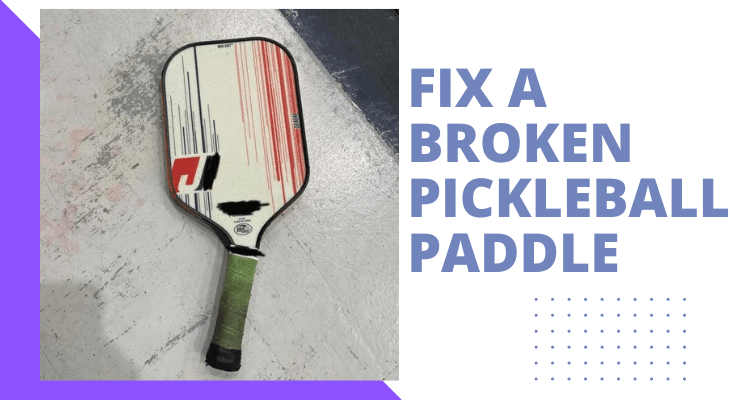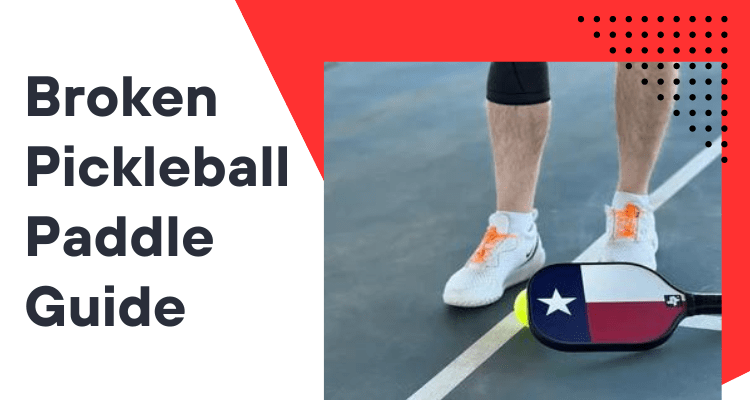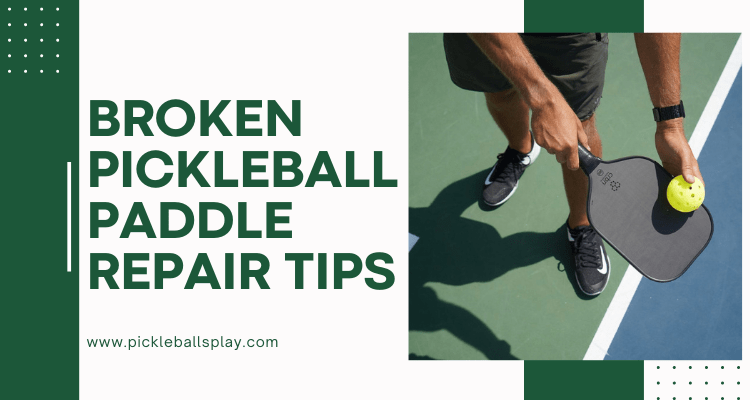Fix a Broken Pickleball Paddle: Pickleball is a fun and popular sport that combines elements of tennis, badminton, and ping-pong. It is played with a paddle and a plastic ball on a court similar to a badminton court. Pickleball is easy to learn and can be enjoyed by people of all ages and skill levels.
However, like any sport, pickleball also comes with some risks of damaging your equipment. Your pickleball paddle is the most important tool in the game, and it can get broken or worn out over time. A broken paddle can affect your performance, safety, and enjoyment of the game.
Fortunately, there are ways to fix a broken pickleball paddle and extend its lifespan. In this article, we will show you how to repair common pickleball paddle problems, such as edge guard scratches, edge guard coming off, edge guard broken, and handle broken. We will also share some tips on how to prevent pickleball paddle damage and some frequently asked questions about pickleball paddle repair.

Broken Pickleball Paddle: How to Fix a Pickleball Paddle Edge Guard
The edge guard is the plastic or rubber strip that covers the edge of the paddle face. It protects the paddle from chipping and cracking when it hits the ground, the net, or another paddle. The edge guard also adds some weight and balance to the paddle.
However, the edge guard can also get damaged over time, especially if you play pickleball frequently or aggressively. Here are some common edge guard problems and how to fix them:
Scratches:
Scratches on the edge guard are usually cosmetic and do not affect the performance of the paddle. However, they can make your paddle look old and worn out. To fix scratches on the edge guard, you can use fine-grit sandpaper or a nail file to gently smooth out the rough edges. You can also apply some clear nail polish or epoxy glue to seal the scratches and prevent further damage.
Edge guard coming off:
Sometimes, the edge guard can come loose or detach from the paddle face due to wear and tear, impact, or poor quality. This can expose the paddle’s core and make it vulnerable to cracking. To fix an edge guard that is coming off, you can use a strong adhesive, such as super glue, epoxy glue, or hot glue, to reattach it to the paddle. Make sure to clean the surface of the paddle and the edge guard before applying the glue. You can also use some clamps or tape to hold the edge guard in place until the glue dries.
The edge guard is broken:
If the edge guard is cracked or broken, you may need to replace it with a new one. You can buy a replacement edge guard online or from a local pickleball store. To replace a broken edge guard, you will need to remove the old one first. You can use a knife, a screwdriver, or a heat gun to pry off the old edge guard. Be careful not to damage the paddle face or the core. Then, you can apply some glue to the new edge guard and press it firmly onto the paddle. You can also use some clamps or tape to secure the edge guard until the glue dries.
How to Fix a Broken Pickleball Handle
The handle is the part of the paddle that you hold and grip. It is usually made of wood, plastic, or composite material, and it is covered with a grip tape or a cushion. The handle is essential for your comfort, control, and power in the game.
However, the handle can also get broken or damaged due to various reasons, such as impact, moisture, or improper storage. Here are some common handling problems and how to fix them:
The handle is loose or wobbly:

If the handle is loose or wobbly, the connection between the handle and the paddle face is weak or broken. This can affect your accuracy, stability, and confidence in the game. To fix a loose or wobbly handle, you can use some glue, screws, or nails to reinforce the connection. You can also wrap some duct tape or electrical tape around the handle to make it more secure.
The handle is cracked or broken:
If the handle is cracked or broken, you may need to replace it with a new one. You can buy a replacement handle online or from a local pickleball store. To replace a broken handle, you will need to remove the old one first. You can use a saw, a knife, or a heat gun to cut off the old handle. Be careful not to damage the paddle face or the core. Then, you can attach the new handle to the paddle using some glue, screws, or nails. You can also wrap some tape around the handle to make it more comfortable and durable.
Grip tape is worn out or peeling off:
The grip tape is the material that covers the handle and provides a soft and comfortable grip. It can also improve your grip strength, sweat absorption, and shock absorption. The grip tape can get worn out or peel off over time due to use, sweat, dirt, or weather. This can make your handle slippery, rough, or uncomfortable. To fix a worn-out or peeling-off grip tape, you can simply replace it with a new one. You can buy a replacement grip tape online or from a local pickleball store. To replace a grip tape, you will need to remove the old one first. You can use a knife or scissors to cut off the old grip tape. Then, you can wrap the new grip tape around the handle, starting from the bottom and working your way up. You can also use some tape to secure the ends of the grip tape.
Reasons for Broken Pickleball Paddle
Pickleball paddle damage can happen for various reasons, some of which are unavoidable and some of which are preventable. Here are some common causes of pickleball paddle damages and how to avoid them:
1. Overusing the paddle
Using the same paddle for a long time or playing pickleball frequently can cause your paddle to wear out faster. The paddle face, the edge guard, and the handle can get scratched, chipped, cracked, or broken due to repeated impact and friction. To avoid overusing your paddle, you can rotate between different paddles or take breaks between games. You can also choose a paddle that is durable and suitable for your playing style and level.
2. Throwing the paddle
Throwing the paddle on the ground, against the wall, or at another player can cause serious damage to your paddle and yourself. The paddle can get bent, warped, or broken due to the force and the angle of the throw. Throwing the paddle can also injure you or someone else, or damage the court or the net. To avoid throwing your paddle, you can control your emotions and frustration, practice good sportsmanship, and respect the rules and etiquette of the game.
3. Not cleaning the paddle
Not cleaning the paddle after each game can cause dirt, sweat, oil, and bacteria to accumulate on the paddle. This can make your paddle dirty, sticky, or smelly, and affect your grip and performance. It can also damage the paddle material and shorten its lifespan. To avoid not cleaning your paddle, you can wipe it with a damp cloth or a mild soap after each game. You can also use some disinfectant spray or wipes to sanitize your paddle and prevent infections.

4. Not covering the paddle
Not covering the paddle when not in use can expose it to sunlight, moisture, dust, or insects. This can fade, warp, or crack the paddle material and affect its quality and appearance. It can also attract mold, mildew, or bugs that can damage the paddle or cause allergies. To avoid not covering the paddle, you can store it in a paddle cover, a case, or a bag when not in use. You can also keep it in a cool, dry, and dark place away from direct sunlight and heat sources.
5. Using a paddle carelessly
Using a paddle carelessly can cause unnecessary damage to your paddle and the environment. For example, hitting the paddle against hard surfaces, such as concrete, metal, or glass, can chip or crack the paddle. Dragging the paddle on the ground, such as gravel, sand, or grass, can scratch or dent the paddle. Leaving the paddle on wet or dirty surfaces, such as puddles, mud, or food, can stain or ruin the paddle. To avoid using a paddle carelessly, you can handle your paddle with care and respect, and avoid contact with anything that can harm your paddle or the environment.
Broken Pickleball Paddle Repair Tips:
Here are some general tips on how to repair your pickleball paddle and make it last longer:
- Always inspect your paddle before and after each game for any signs of damage or wear and tear. If you notice any problems, fix them as soon as possible to prevent them from getting worse.
- Use the right tools and materials for your pickleball paddle repair. For example, use glue that is compatible with your paddle material, sandpaper that is suitable for your paddle surface, and grip tape that matches your paddle size and shape.
- Follow the instructions and guidelines for your pickleball paddle repair. For example, apply the glue evenly and sparingly, sand the scratches gently and smoothly, and wrap the grip tape tightly and neatly.
- Test your paddle after your pickleball paddle repair. For example, check the stability.
- Test your paddle after your pickleball paddle repair. For example, check the stability and alignment of the edge guard and the handle, the paddle face’s smoothness and cleanliness, and the grip tape’s comfort and grip. You can also play a few games with your paddle to see how it feels and performs.
- Clean and maintain your paddle regularly. For example, wipe your paddle with a damp cloth or mild soap after each game, store your paddle in a cover or a case when not in use, and avoid exposing your paddle to extreme temperatures or humidity.
FAQs:
Here are some frequently asked questions about pickleball paddle repair and their answers:
What is the lifespan of a pickleball paddle?
The lifespan of a pickleball paddle depends on several factors, such as the quality and material of the paddle, the frequency and intensity of use, the care and maintenance of the paddle, and the environmental conditions. Generally, a good-quality pickleball paddle can last for several years if used and maintained properly. However, some signs of aging and deterioration are inevitable, such as fading, yellowing, or cracking of the paddle surface, loosening or breaking of the edge guard or the handle, or wearing out or peeling off of the grip tape. If your paddle shows any of these signs, you may need to repair or replace it.
How Often Do Pickleball Paddles Break?
Pickleball paddles are designed to be durable and resilient, but they can still break under certain circumstances. The most common causes of pickleball paddle breakage are impact, moisture, and heat. For example, hitting the paddle against hard objects, such as the ground, the net, or another paddle, can cause the paddle to crack or shatter. Leaving the paddle in wet or humid conditions, such as rain, snow, or sweat, can cause the paddle to warp or rot. Exposing the paddle to high or low temperatures, such as sunlight, fire, or frost, can cause the paddle to melt or freeze. If your paddle breaks, you may need to replace it with a new one.
Can You Play With a Broken Pickleball Paddle?
Playing with a broken pickleball paddle is not recommended, as it can affect your game and your safety. A broken paddle can reduce your accuracy, power, and control in the game, as well as increase your risk of injury or damage. For example, a cracked or chipped paddle can cause the ball to bounce unpredictably, a loose or wobbly handle can cause the paddle to slip out of your hand, and a broken edge guard can expose the sharp edges of the paddle.
Broken Pickleball Paddle: The Ending Words:
Pickleball paddle repair is a skill that every pickleball player should learn and practice. It can help you save money, time, and hassle, as well as improve your game and your enjoyment of the sport. By following the steps and tips in this article, you can fix common pickleball paddle problems, such as edge guard scratches, edge guard coming off, edge guard being broken, and handle breaking. You can also prevent pickleball paddle damage by taking good care of your paddle and using it properly. We hope this article has been helpful and informative for you. Happy pickleballing!




